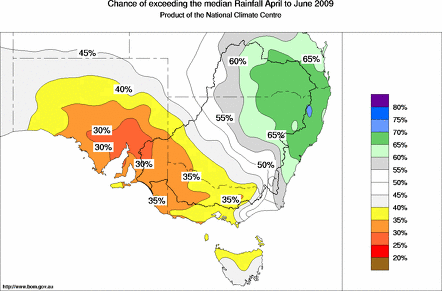| Southeastern Aust Seasonal Rainfall Outlook: probabilities for April to June 2009, issued 24th March 2009 | |||||||||
Contrasting June-quarter rainfall odds across SE AustraliaFor southeastern Australia, the outlook for total June quarter rainfall (April-June), shows a moderate shift in the odds favouring wetter than normal conditions over eastern and northern NSW. In contrast, there is a moderate to strong shift in the odds favouring drier than normal conditions over much of South Australia, Victoria and northern Tasmania. The pattern of seasonal rainfall odds across southeast Australia is mainly a result of warm conditions in the Indian Ocean in February; the Pacific Ocean had little contribution to this forecast. 
For the April to June period, the chance of exceeding median rainfall is between 60 and 70% in a region covering much of eastern and northern NSW (see map). This means that for every ten years with ocean patterns like the current, about six or seven years are expected to be wetter than average over this area, while about three or four years are expected to be drier. Conversely, the chance of above median rainfall is below 40% in a band extending from northwest SA across southwest NSW and Victoria (except East Gippsland) to northern Tasmania (see map). The probabilities drop below 30% in the central pastoral districts of South Australia. This means that below median falls, i.e. drier than normal conditions, have a 60 to 75% chance of occurring across this broad region. In other words, for every ten years with ocean patterns like the current, about six to seven years are expected to be drier than normal in these areas. New: Under the WATL part of the Bureau's website, there is an expanded set of seasonal rainfall outlook maps and tables, including the probabilities of seasonal rainfall exceeding given totals (e.g. 200 mm). Outlook confidence is related to how consistently the Pacific and Indian Oceans affect Australian rainfall. During April to June, history shows this effect to be moderately consistent in a band covering most of South Australia, the far southwest of NSW and over most of Victoria. There is also a moderate consistency over most of the northeast corner of NSW and the eastern half of Tasmania. However, confidence is only weakly to very weakly consistent in a band stretching from northeast SA to southeast NSW and part of western Tasmania (see background information). In these areas where outlook confidence is not high caution should be used when interpreting these outlooks. Pacific climate patterns were bordering on La Niña for several months, with above average wet season falls in the Australian tropics a direct result. The equatorial Pacific Ocean is warming and the consensus from computer models is for near average temperatures in the middle of the year. The SOI remains positive at approximately +3 for the 30 days ending 21 March. For routine updates and comprehensive discussion on any developments please see the ENSO Wrap-Up. | |||||||||
Click on the map above for a larger version of the map. Use the reload/refresh button to ensure the latest forecast map is displayed. More detailed forecast maps, including the probabilities of seasonal rainfall exceeding given totals, can be found here. | |||||||||
|
More information on this outlook is available Monday to Friday from 9.00am to 5.00pm local time by contacting the Bureau's Climate Services sections in Queensland, NSW, SA, Victoria and Tasmania at the following numbers:
| |||||||||
THE NEXT ISSUE OF THE SEASONAL OUTLOOK IS EXPECTED BY 24th April 2009 Corresponding temperature outlook February 2009 rainfall in historical perspective December 2008 to February 2009 rainfall in historical perspective | |||||||||
Background Information
| |||||||||









